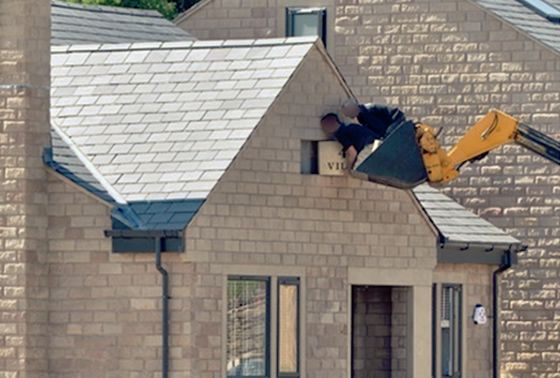
Fine for building firm highlights importance of regulations

In January 2023, the Health & Safety Executive announced that it had fined a Greater Manchester building firm for a series of health and safety breaches on a new build development. For many, including those of us who are specialists in work accident compensation claims, the failures by the firm are astonishing.
The photograph above shows the most eye-catching breaches of health and safety regulations by the company. It shows workers standing in the bucket of a digger being lifted to the top of the exterior wall to fit a stone.
In fact, the company was fined for a number of other breaches as well. These included a lack of sufficient welfare facilities for workers, insecure fencing and inadequate protection from silica dust exposure which can cause lung conditions. The firm was fined £120,000 and ordered to pay an additional amount in costs.
What law applies?
There are two main sets of regulations which apply here and which appear to have been seriously breached. The first is the Construction (Design and Management) Regulations 2015. These apply to any place where construction work is being carried out. The regulations impose duties on a wide range of parties involved in a project, including designers, principal contractors and sub-contractors. Designers and contractors must have the necessarily skills, experience and capability to undertake the work. The regulations place great emphasis on the importance of planning in both the pre-construction phase and the construction phase. There are duties on designers and contractors to draw up comprehensive plans. They are required to show that plans take full account of all matters relating to health and safety. As the work continues, a contractor must manage, monitor and co-ordinate work undertaken during the construction phase.
The other key piece of legislation is the Work at Height Regulations 2005. These regulations apply to any work which is done at height, even if it is not at significant height above ground level. When work at height cannot be avoided altogether, the duties on the contractor include an emphasis on ensuring that work at height is properly planned. There is a duty to carry out a full risk assessment and to ensure that work at height is carried out safely as reasonably practicable. Crucially for the Greater Manchester firm, the regulations require that suitable work equipment must be provided for use whenever employees are undertaking work at height.
Given the emphasis in the regulations on proper planning of all matters of Health & Safety and the provision of suitable equipment, it is easy to see why the company was fined so heavily. For the tasks shown in the photograph, it is abundantly clear that scaffolding ought to have been provided.
Even if scaffolding had been provided, other duties would also have arisen in relation to this particular task, including under the Manual Handling Operations Regulations 1992 - for the method by which the stone was to be moved by employees on the scaffolding.
This example serves as a salutary reminder to all of the importance of compliance with the regulations.
If you have a question about a construction site injury, or other injury due to a workplace accident, please get in touch with us.
Email Stephen Irvine
Call our personal injury claims team free on 0808 560 0872
Arrange a callback by using our enquiry form
Share this page
- Personal injury claims
- Our personal injury team
- How to make a personal injury compensation claim
- How to choose a personal injury solicitor
- Claim now
- Personal injury claim calculator
- How claims are valued
- Frequently asked questions
- Types of personal injury claim
- How to sue someone in the Scottish courts
- Recent successes
- Testimonials
- Injury Compensation Alliance

